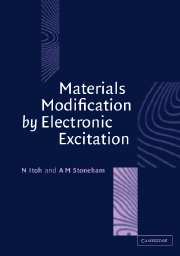Book contents
- Frontmatter
- Contents
- Preface
- 1 Concepts: Excitation, polarons and electronic structure
- 2 Energy deposition and redistribution in solids
- 3 Electron–lattice coupling and its consequences
- 4 Self-trapping
- 5 Local lattice modification by electronic excitation of halides
- 6 Local lattice modification by electronic excitation of crystalline insulating oxides
- 7 Local lattice modification of semiconductors by electronic excitation
- 8 Local lattice modification of amorphous materials by electronic excitation
- 9 Atomic emission and surface modification
- 10 Interface reactions induced by electronic excitation
- 11 High excitation intensities
- 12 Applications of materials modification by excitation
- References
- Index
4 - Self-trapping
Published online by Cambridge University Press: 11 August 2009
- Frontmatter
- Contents
- Preface
- 1 Concepts: Excitation, polarons and electronic structure
- 2 Energy deposition and redistribution in solids
- 3 Electron–lattice coupling and its consequences
- 4 Self-trapping
- 5 Local lattice modification by electronic excitation of halides
- 6 Local lattice modification by electronic excitation of crystalline insulating oxides
- 7 Local lattice modification of semiconductors by electronic excitation
- 8 Local lattice modification of amorphous materials by electronic excitation
- 9 Atomic emission and surface modification
- 10 Interface reactions induced by electronic excitation
- 11 High excitation intensities
- 12 Applications of materials modification by excitation
- References
- Index
Summary
In this chapter, we shall analyse the way self-trapping occurs in real systems. The first issue is whether or not self-trapping is observed in a given material. We have discussed the criteria for self-trapping in Section 3.3, but experiment is the decisive factor. Table 4.1 shows the occurrence of self-trapping of electrons, holes, and excitons in a number of insulators. The absence of self-trapping of electrons and holes can be determined by measuring their mobilities; the absence of self-trapping of excitions is demonstrated by observing freeexciton luminescence. When the interaction of free charge carriers and of excitons with defects or impurities indicates long-range motion, this can imply the absence of self-trapping. Once self-trapping is proven, the atomic and electronic structures of the self-trapped states are needed. The relationship between the self-trapped state and the host atomic and electronic structure is important, especially for self-trapped excitions, since exciton self-trapping provides the energy localisation needed for local modification of the lattice structure and defect formation.
Although self-trapping is induced as a consequence of coupling with the lattice, existing defects play a role in self-trapping in two ways: extrinsic self-trapping and defect-perturbed self-trapping. Extrinsic self-trapping occurs by the interaction with the lattice and defects in materials in which the interaction with the lattice is not sufficient to induce intrinsic self-trapping, while defect-perturbed self-trapping occurs by the interaction between intrinsic self-trapping and defects (Fig. 4.1). Trapping by defects without self-trapping does not involve large lattice distortion.
- Type
- Chapter
- Information
- Materials Modification by Electronic Excitation , pp. 138 - 186Publisher: Cambridge University PressPrint publication year: 2000



